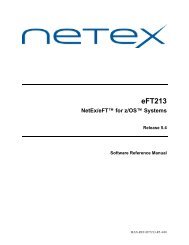Software Reference Manual - NetEx
Software Reference Manual - NetEx
Software Reference Manual - NetEx
You also want an ePaper? Increase the reach of your titles
YUMPU automatically turns print PDFs into web optimized ePapers that Google loves.
Notice that a SEND in one job must match a RECEIVE in the other job.<br />
The BFXTI program sends the file identified by the INDD parameter. In this case, the IN01 DD statement<br />
specifies that the BMD member is to be sent. This member is sent to the RESPOND job, which receives it and<br />
calls it MEMBER3, as specified in the OUT01 DD statement.<br />
Notice that the pair of commands, SEND in the INITIATE procedure and RECEIVE in the RESPOND procedure,<br />
trigger the transfer.<br />
The BFXTR and BFXTI programs continue processing. The RESPOND job then SENDs member NSEF001<br />
over the network. BFXTI RECEIVEs it as MEMBER2 as specified by the OUT01 DD statement in the<br />
INITATE job.<br />
The BFXTR and BFXTI programs continue processing. The INITIATE job SENDs member BMC over the<br />
network. BFXTR RECEIVEs it as MEMBER4 as specified by the OUT02 DD statement in the RESPOND<br />
job.<br />
BFXTR scans the RESPOND commands and does not find any other BFX commands. BFXTR ends processing.<br />
BFXTI scans the INITIATE commands and does not find any commands, then ends also.<br />
There are several important points related to the preceding example.<br />
<br />
<br />
<br />
<br />
Either the BFXTI or the BFXTR side of the transfer can send or receive files.<br />
Each SEND statement must have a matching RECEIVE statement in the partner procedure.<br />
The IDs must match in the initiating and responding procedures.<br />
This example shows BFXTI in host ZOS1 and BFXTR in host ZOS2. Normally, all three programs would<br />
exist in each host to allow either side to initiate a session.<br />
Automatic Job Submission<br />
Automatic job submission is the most commonly used method of transferring files using BFX. This method<br />
enables a user to transfer files to and/or from a responding system without user assistance on the responding<br />
system.<br />
The user must first prepare an initiating job similar to the one used for manual job submission. This job identifies<br />
the responding host and defines the direction of the transfer. This job also describes the data and any<br />
special processing to be performed on the data.<br />
The user must also prepare a set of job control information for the responding job and specifies the direction<br />
of the transfer. This responding job, written using the control language of the responding host, is physically<br />
encapsulated (or referenced) in the initiating job.<br />
The basic idea of automatic job submission is that the initiating job first transfers the responding job across<br />
the IP network (using BFXTI). The BFX Job Submitter (BFXJS) program receives this responding job and<br />
automatically submits it on its host system. The BFXTI and BFXTR programs then coordinate the transfer of<br />
the files as they did for manual job submission.<br />
The initiating and responding hosts may be any host that has the appropriate NETEX and BFX products installed,<br />
but to simplify the discussion we will assume both hosts are IBM z/OS systems.<br />
The sample initiating job (Figure 4 on page 6) and the following text and diagrams illustrate the automatic job<br />
submission process.<br />
MAN-REF-H211-05 Introduction Page 5















